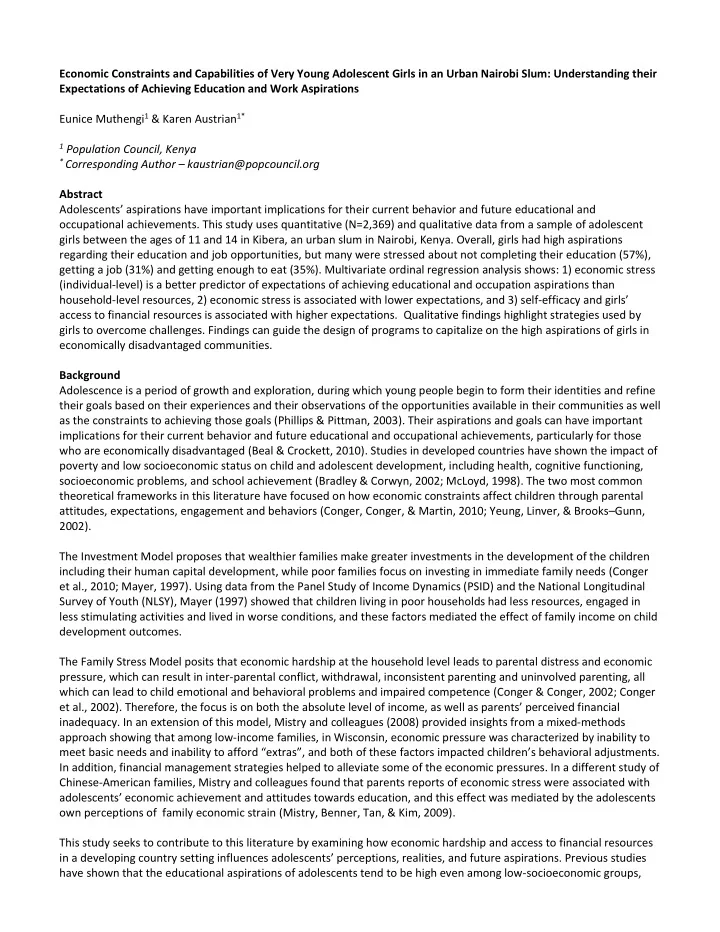

Economic Constraints and Capabilities of Very Young Adolescent Girls in an Urban Nairobi Slum: Understanding their Expectations of Achieving Education and Work Aspirations Eunice Muthengi 1 & Karen Austrian 1* 1 Population Council, Kenya * Corresponding Author – kaustrian@popcouncil.org Abstract Adolescents’ aspirations have important implications for their current behavior and future educational and occupational achievements. This study uses quantitative (N=2,369) and qualitative data from a sample of adolescent girls between the ages of 11 and 14 in Kibera, an urban slum in Nairobi, Kenya. Overall, girls had high aspirations regarding their education and job opportunities, but many were stressed about not completing their education (57%), getting a job (31%) and getting enough to eat (35%). Multivariate ordinal regression analysis shows: 1) economic stress (individual-level) is a better predictor of expectations of achieving educational and occupation aspirations than household-level resources, 2) economic stress is associated with lower expectations, and 3) self-efficacy and girls’ access to financial resources is associated with higher expectations. Qualitative findings highlight strategies used by girls to overcome challenges. Findings can guide the design of programs to capitalize on the high aspirations of girls in economically disadvantaged communities. Background Adolescence is a period of growth and exploration, during which young people begin to form their identities and refine their goals based on their experiences and their observations of the opportunities available in their communities as well as the constraints to achieving those goals (Phillips & Pittman, 2003). Their aspirations and goals can have important implications for their current behavior and future educational and occupational achievements, particularly for those who are economically disadvantaged (Beal & Crockett, 2010). Studies in developed countries have shown the impact of poverty and low socioeconomic status on child and adolescent development, including health, cognitive functioning, socioeconomic problems, and school achievement (Bradley & Corwyn, 2002; McLoyd, 1998). The two most common theoretical frameworks in this literature have focused on how economic constraints affect children through parental attitudes, expectations, engagement and behaviors (Conger, Conger, & Martin, 2010; Yeung, Linver, & Brooks – Gunn, 2002). The Investment Model proposes that wealthier families make greater investments in the development of the children including their human capital development, while poor families focus on investing in immediate family needs (Conger et al., 2010; Mayer, 1997). Using data from the Panel Study of Income Dynamics (PSID) and the National Longitudinal Survey of Youth (NLSY), Mayer (1997) showed that children living in poor households had less resources, engaged in less stimulating activities and lived in worse conditions, and these factors mediated the effect of family income on child development outcomes. The Family Stress Model posits that economic hardship at the household level leads to parental distress and economic pressure, which can result in inter-parental conflict, withdrawal, inconsistent parenting and uninvolved parenting, all which can lead to child emotional and behavioral problems and impaired competence (Conger & Conger, 2002; Conger et al., 2002). Therefore, the focus is on both the absolute level of income, as well as parents’ perceived financial inadequacy. In an extension of this model, Mistry and colleagues (2008) provided insights from a mixed-methods approach showing that among low-income families, in Wisconsin, economic pressure was characterized by inability to meet basic needs and inability to afford “extras”, and both of these factors impacted children’s behavioral adjustments. In addition, financial management strategies helped to alleviate some of the economic pressures. In a different study of Chinese-American families, Mistry and colleagues found that parents reports of economic stress were associated with adolescents’ economic achievement and attitudes towards education, and this effect was mediated by the adolescents own perceptions of family economic strain (Mistry, Benner, Tan, & Kim, 2009). This study seeks to contribute to this literature by examining how economic hardship and access to financial resources in a developing country setting influences adolescents’ perceptions , realities, and future aspirations. Previous studies have shown that the educational aspirations of adolescents tend to be high even among low-socioeconomic groups,
Recommend
More recommend